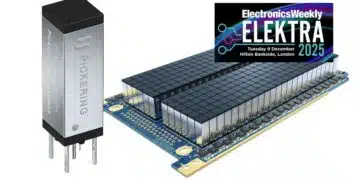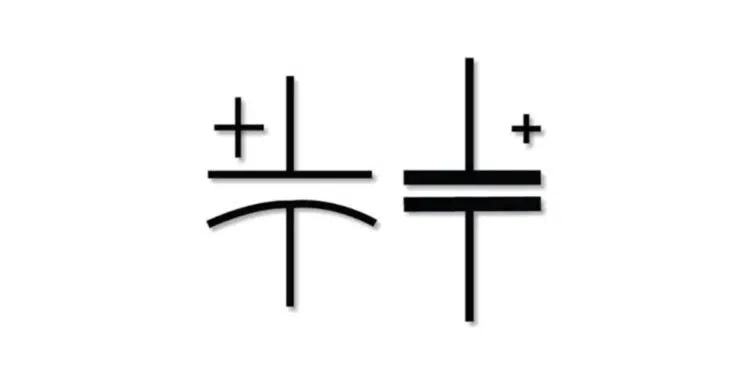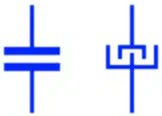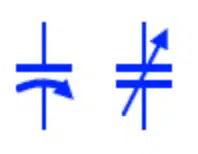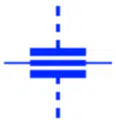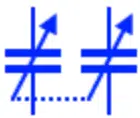This article shows some common and also not so known capacitor symbols with brief description.
Key Takeaways
- The article describes various capacitor symbols along with their functions.
- There are more symbol standards: Europe (IEC “new”), US (IEEE “old”) or symbols used in Japan.
- Generic capacitors store energy and can connect in any direction, while polarized electrolytic capacitors have positive and negative terminals.
- Variable capacitors allow for adjustable capacitance, commonly used in tuning circuits.
- Specialized capacitors like temperature-dependent and voltage-dependent capacitors have unique characteristics and applications.
- The article also discusses unique designs such as differential, butterfly, and dual ganged capacitors for advanced circuit functionality.
Capacitor Symbols
Generic Capacitor
Capacitor is an electronic component that stores energy in its electric field. It is the symbol of a generic capacitor. It is a non-polar electrostatic capacitor having fixed capacitance value such as ceramic capacitors, silicon capacitors or film capacitors from the most common types. It can be connected in either direction. The second symbol represents an obsolete capacitor symbols used for non-polar capacitors.
Polarized Electrolytic Capacitor
Such type of capacitors uses electrolyte as one of its electrode that is why they are polarized. The electrolytic capacitors such as aluminum capacitors, tantalum capacitors / niobium capacitors or supercapacitors have positive and negative terminals and the top of these symbols represent the positive terminals. A polarized capacitor must be connected in circuit accordingly, otherwise it may fail in its function. The first two symbols are used in Europe (IEC “new”) while the next two symbols in US (IEEE “old”) . The 5th symbol for capacitor is used in japan.
Variable Capacitor
This symbol represents a variable capacitance whose capacitance can be varied during normal operation. The capacitance is varied by increasing or decreasing the effective area between the plates that effects the capacitance of the capacitor. They are used in LC tuning circuits.
Trimmer Capacitor
It is also a variable capacitor whose capacitance is used to calibrate a circuit during manufacturing or troubleshooting a circuit. The capacitance of such capacitor is not normally changed by users during operation.
Bipolar Capacitor
They are also known as non polar electrolytic capacitor, usually aluminum electrolytic bipolar capacitors. It is made of two electrolytic capacitor in such design that they can be used in any polarity. They differ from generic ceramic non polar capacitor by having large capacitance.
Feed through Capacitor
This type of capacitor is designed for DC power supply in RF systems. It supply the pure DC signal & also filters any RF component from it.
Voltage Dependent Capacitor
The capacitance of such capacitor depend on the applied voltage. Increasing or decreasing the supply voltages changes the size of the dielectric gap between the plates which increases the capacitance.
Temperature Dependent Capacitor
These capacitors capacitance depends on its surrounding temperature. The temperature increase or decrease may increase or decrease the capacitance of the capacitor. They are used in temperature sensing application.
Differential Capacitor
It is a variable capacitor with two operate stator and one common rotor. Moving the rotor increases the capacitance in one section & simultaneously decreases it in the other section. However the total capacitance remains the same.
Split Stator Capacitor
As the name suggest, such type of variable capacitor has two set of stators that are separated at 180° . A common shaft rotates the rotor that has the same vanes placed 180° apart. Such capacitors do not have the 90° limitation of a generic variable capacitor.
Dual Ganged Capacitor
It is the combination of two variable capacitor. The variable rotor of these both capacitors is controlled using a single shaft. Thus they provide variable capacitance in both capacitors by moving a single rotor.
Butterfly Capacitor
Such type of variable capacitor has two separate stators opposite to each other mounted on the body of the capacitor. The rotor whose plates are also butterfly shaped, rotates between these two stators. The capacitance in such capacitor varies equally between either stator & rotor. They are used in symmetrically tuned circuits.
Tempatrimmer / Thermotrimmer
Tempatrimmer or also known as thermotrimmer is a small trimmer capacitor with a variable temperature coefficient. They are used in stabilizing the drifting VFos.
Frequently Asked Questions about Capacitor Symbols
The generic capacitor symbol represents a non-polar capacitor with a fixed capacitance value. It can be connected in either direction and is commonly used in circuit diagrams.
Polarized electrolytic capacitors are marked with positive and negative terminals. The symbol indicates polarity, and incorrect connection can cause the capacitor to fail or explode.
A variable capacitor allows capacitance adjustment during normal operation, often used in tuning circuits. A trimmer capacitor is adjusted only during manufacturing or calibration and not by end users.
Feed-through capacitors filter RF noise in DC power lines, while temperature-dependent capacitors change capacitance with temperature, making them useful in sensing applications.










